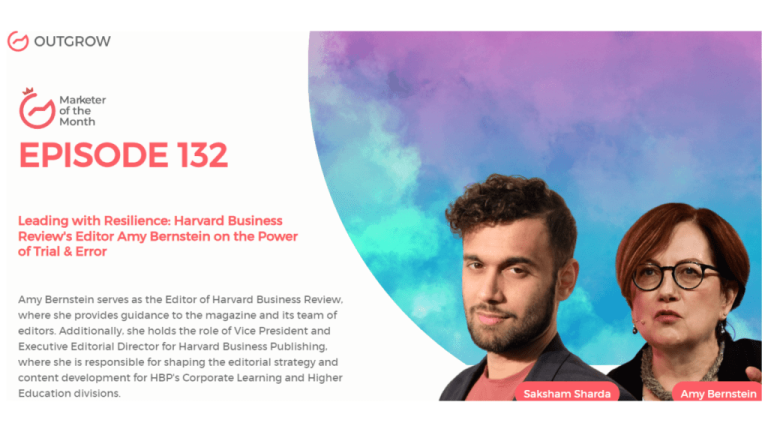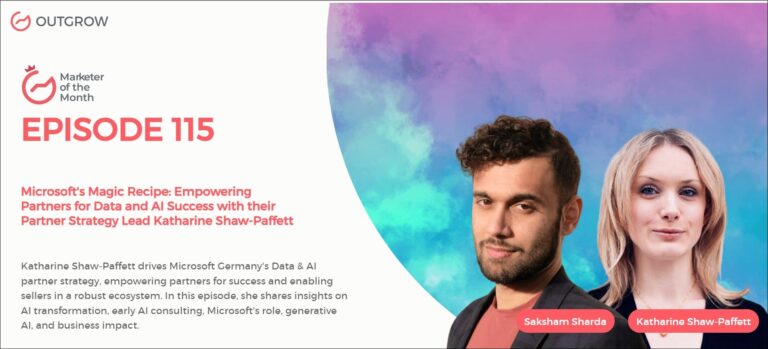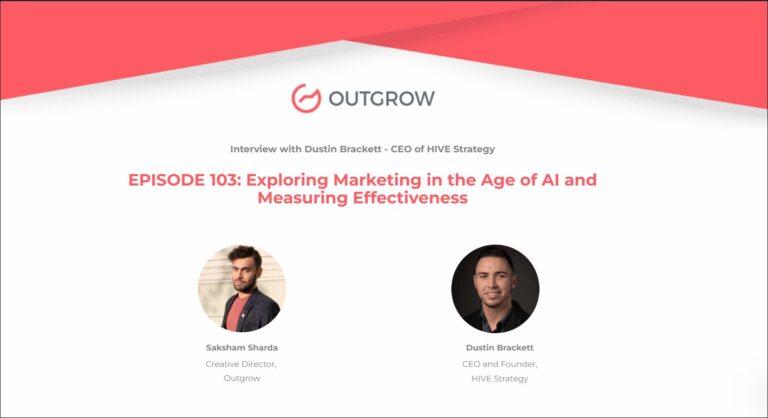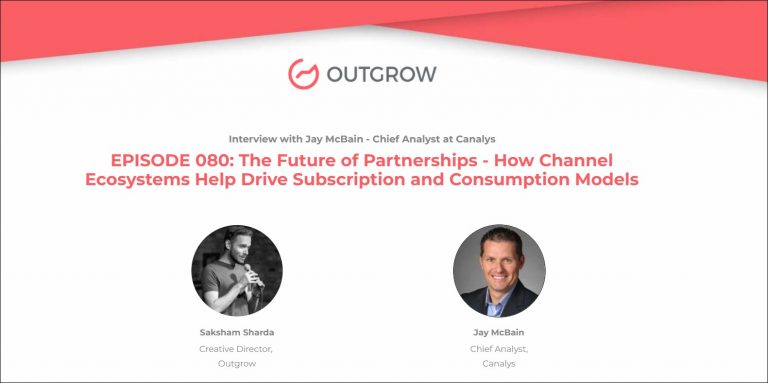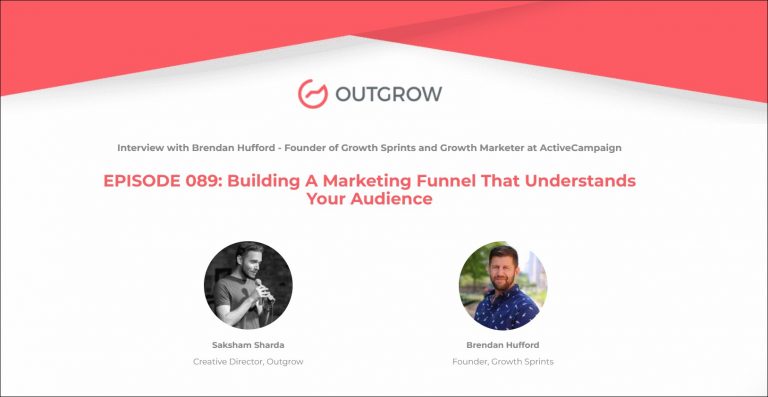Marketer of the Month Podcast Episode With Katelyn Bourgoin
Table of Contents
Hey there! Welcome to the Marketer Of The Month blog!
We recently interviewed Katelyn Bourgoin for our monthly podcast – ‘Marketer of the Month’! We had some amazing insightful conversations with Katelyn and here’s what we discussed about –
1. How customer camp helps product teams make better decisions and market smarter
2. Overspending on social media ads – how it can affect your overall marketing strategy
3. Driving risk-taking and innovation in your marketing teams
4. Customer and Industry Insights are the best tools in a marketer’s arsenal
5. Connecting with the prospect – how psychology in marketing shapes your offering
6. Crucial components of a successful market research
About Our Host:
Dr. Saksham Sharda is the Chief Information Officer at Outgrow.co He specializes in data collection, analysis, filtering, and transfer by the means of widgets and applets. Interactive, cultural, and trending widgets designed by him have been featured on TrendHunter, Alibaba, ProductHunt, New York Marketing Association, FactoryBerlin, Digimarcon Silicon Valley, and at The European Affiliate Summit.
About Our Guest:
Featured in USA Today, HuffPost, CBC, and CTV, and having been named as an “influential entrepreneur” by Forbes, Katelyn Bourgoin has been both a founder and a top-grade marketer – striving to understand customers in the best way possible. Tune in to hear about her success at Customer Camp and what it means to be in the game long enough.
How to Supercharge Your Marketing by Simply Learning From Your Customers
The Intro!
Saksham Sharda: Hi everyone. Welcome to another episode of Outgrow’s Marketer of the Month. I’m your host, Dr. Saksham Sharda. I’m the creative director at Outgrow.co. And for this month, we are going to interview Katelyn Bourgoin, CEO and lead trainer at Customer Camp. Thanks for joining us, Katelyn.
Katelyn Bourgoin: Thank you so much for having me.
Don’t have time to read? No problem, just watch the Podcast!
Or you can just listen to it on Spotify
The Rapid Fire Round!
Saksham Sharda: So Katelyn, we’re gonna start with a rapid-fire round just to break the ice. You get three passes in case you don’t want to answer the question. You can just say pass, but try to keep your answers to one word or one sentence only. Okay?
Katelyn Bourgoin: Okay! This is hard for me, cuz I’m very verbose. So let’s do this.
Saksham Sharda: At what age do you want to retire?
Katelyn Bourgoin: Never.
Saksham Sharda: How long does it take you to get ready in the mornings?
Katelyn Bourgoin: Four minutes.
Saksham Sharda: Most embarrassing moment of your life?
Katelyn Bourgoin: There’s probably plenty, but none that can pass.
Saksham Sharda: Favorite color.
Katelyn Bourgoin: Black.
Saksham Sharda: What time of day are you most inspired?
Katelyn Bourgoin: Mornings, usually between 9 and 11.
Saksham Sharda: How many hours of sleep can you survive on?
Katelyn Bourgoin: Six
Saksham Sharda: Fill in the blank. An upcoming marketing trend is _______.
Katelyn Bourgoin: Pass
Saksham Sharda: The city in which the best kiss of your life happened.
Katelyn Bourgoin: Halifax
Saksham Sharda: Pick one. Mark Zuckerberg or Jack Dorsey.
Katelyn Bourgoin: Jack Dorsey.
Saksham Sharda: The first movie that comes to your mind. When I say the word ambition.
Katelyn Bourgoin: Pass.
Saksham Sharda: When did you last cry and why?
Katelyn Bourgoin: Probably a few days ago from new mom/entrepreneur stress.
Saksham Sharda: Okay. All right. Just to let you know, you’re out of passes.
So, how do you relax?
Katelyn Bourgoin: Alcohol
Saksham Sharda: How many cups of coffee do you drink per day?
Katelyn Bourgoin: Two to three
Saksham Sharda: A habit of yours that you hate
Katelyn Bourgoin: Stress eating.
Saksham Sharda: The most valuable skill you’ve learned in life
Katelyn Bourgoin: Writing.
Saksham Sharda: And the last question is – Your favorite Netflix show?
Katelyn Bourgoin: Right now? Maybe stranger things.
Saksham Sharda: Okay, well you scored 7 on 10 because you had three passes, but we’re not gonna include that. You’re gonna win a car. Just kidding. You don’t win anything. We can’t afford that.
Katelyn Bourgoin: Like you get a car, you get a car?
Saksham Sharda: Yeah, you get a car. All right.
The Big Questions!
Saksham Sharda: So, the long-form questions, the first one is, can you explain what customer camp is and how does it differ from other such agencies out there?
Katelyn Bourgoin: Sure. So one way that we differ is that we’re not an agency. So, while we do some done for you research occasionally, and some consulting work, for the most part, we are a training company. So we work with, a lot of incubators and accelerators often that support high growth companies like tech startups, or D2C startups. And we train them on how to identify who their best customers are and really understand why those customers buy. So that’s our core business.
And in addition to that, we kind of have a secondary line of business, which is new and emerging and that’s the media side of the company. So our newsletter, Why We Buy, is something that we started about a year ago. It’s growing quickly, a lot of interest from sponsors and things to be part of that. So we’re looking at taking why we buy and building out, the media side of the business around that almost as its own brand. So while we do some research for your research work for clients, that’s really not the core of our business. Our core business is, are training and content.
Saksham Sharda: And what made you focus more on the media side at this point?
Katelyn Bourgoin: I love it. I think it’s a lot of fun. And I think that oftentimes when you feel pulled from the market, you recognize that and you identify, is this an opportunity I wanna move on or not? And so for us, it was always very easy for us to get our incubator and accelerator partners, to hire us to do training, a little harder to get individual marketers inside of companies or, marketers for hire, you know, other agencies, freelancers consultants, a little harder to get them to come. And part of the reason why is that?
I often say that audience research, customer research, buyer research, the kind of stuff that we’re really nerdy about it is really, really good for you and very important. And in that way, it’s kind of like diet and exercise. Like the best way for somebody to lose weight is diet and exercise.
Katelyn Bourgoin: But nobody likes that answer. So people will search for any other solution that they can and often try other things first before they find their way to us, they start to realize that kind of the growth hacks and the silver bullets that their promises aren’t working and that they really do need to double down and understand their buyers. And so for us, there was this question kind of internally around this is, you know, we know that the training side of the business is doing well. Do we wanna scale-up and kind of offer a second line of business and actually do more done for your research coz we had a lot more demand than we were able to take on, but I’d run an agency in the past.
So I had a branding agency that was my first company and I wasn’t sure that I wanted to grow another agency. So I was really kind of like coming and highing over the approach. And then as interest in the way we buy media side of the company continued to kind of bubble up. I thought, well maybe there’s a different way to get to the place that I wanna be, which is to grow revenue in the company without having to grow headcount really quickly. So that has been the focus now.
Saksham Sharda: And speaking of customer research businesses is spending more than ever on social media ads. Do you think it’s worth it to spend money on ads without knowing your customers?
Katelyn Bourgoin: I think that there was a time when certain platforms, particularly Facebook, were pretty good at doing a lot of the marketers work for them, but not great. You still need to have a good product and a decent message. You need to have a good product and you need to have a great message, but the platforms were, were better at being able to find people who might be interested in an offer like yours and there’s, they were never great at it, but they were better now. They’re not very good at it. And it’s never been more important for marketers to invest in audience research before they spend money on ads. It’s just critically important without it you’re basically burning capital. So while it’s really important, the industry hasn’t quite caught up.
There are a lot of, you know, internal teams that have been doing this forever and they see the results, lots of agencies that this is their secret sauce, but it is something where the market is now starting to move and realize the importance of this. But it just takes a lot of people like myself, going out and yelling about the importance of it for several years. And I first started talking about the importance of this 2018 really publicly. And I’ve seen a lot of shifts since then a lot where people have kind of joined the chorus, singing about how important this is a lot of great companies that have had big splashy exits, credit customers, recite customer research and insight to the core of their success. But it’s still something people are coming to discover and appreciate fully.
Saksham Sharda: And, when it comes to, the psychology of marketing itself, the messaging. So when it comes to messaging, what role does psychology play in marketing, according to you?
Katelyn Bourgoin: So, so much because one of the things that I often say when it comes to messaging is what you say is important, but how you say it matters more, and understanding first, you need to really understand what the core motivation is that a prospect might have that would in make them wanna pay attention to an offer like yours, right? That would perk their interest.
You need to understand when those people might be in the market to buy what you offer. Coz oftentimes marketers, in particular, focus on who the people are when what’s much more important is when those people might be triggered to wanna buy a product like ours. That being said, even when you know who they are and you know, when they might be a market for a solution, there are still so many different ways that you can shape your offering, ways that you can compare you know, what you can compare it to, how to frame your offer.
Katelyn Bourgoin: So it’s really exciting how to, make it, you know, resonate with a prospect in a way that maybe it won’t. And so it’s this, the more you understand your audience like that’s step one, you really need to understand your audience. And then beyond that, stepping more broadly and thinking about understanding people and what really motivates and drives people kind of our core psychology cuz one of the things I often say is that marketing channels and tactics and tools, all of that changes really, really quickly.
And if you’re focused on always being ahead of the next trend and figuring out, you know, what the next channel’s going to be, that’s great for established companies that have lots of resources. It’s a lot harder for smaller businesses that need to decide where they’re going to invest. And while those channels and tools are changing rapidly, the people that are, that are using them, the people on the other end, don’t change rapidly. You know, humans, humans are hardware is, is so old and it doesn’t change fast. And so understanding people is something that a lot more people should take the time to invest in. It’s equally important as understanding the tactical stuff. And it gets oftentimes a lot less attention.
Saksham Sharda: So what can businesses do to get closer to their customers in your opinion, what do businesses need right now?
Katelyn Bourgoin: So my absolute favorite method that I’ve found, and this is through being an entrepreneur for 12 years, as I said, running my own agency, working with big brands like Target, Holiday Inn launching my own Russia consulting company, selling that launching a tech company, making it, you know, we were once called by Forbes, the next LinkedIn for women.
Like I’ve been in this space for a long time trying to figure this out. And I’ve worked with a lot of companies that are also trying to figure it out. And for me, the tool that I have found that is the most helpful is actually talking to people who have recently bought from you and not asking them to tell you about what they think of your product or service. Well, of course, that’s interesting. That’s not the number one thing. What you really wanna understand is you wanna basically pull out all of the details of their buying journey.
Katelyn Bourgoin: So what led them to realize that they might have a problem that solution makers could solve? What other things have they tried or considered or explored along the journey of defining your product? Why didn’t those solutions work for them, who was involved in the buying decision? What did they hope to achieve? Like from a goals perspective, the kind of more functional things, but then beyond that, what we’re kind of their selfish desires? What were they hoping to achieve themselves? That was really their core motivation. And there are so many details that come out of these interviews that you can just get way more laser-focused on understanding buyers through this method.
So I would say that’s one of the best ways to get closer to your customers. Cuz again, a phrase I often say is empathy, doesn’t travel through osmosis, right? You can’t just talk to people on your sales team or you know, maybe the founders experienced the problem themselves and that’s why they started the business.
Katelyn Bourgoin: But you can’t just talk to the leadership and hope that as a marketer, you’re gonna be able to pull everything you need to know out of those people because well, of course, they’ll freely share as much customer information as they have. You really do need to have an opportunity to talk to customers and marketing has not always been expected or allowed to do that.
And so again, I think we’re seeing this sea tide change of organizations recognizing that how can a marketer do their job if they don’t deeply empathize with the buyers and we need to let marketers go out there and talk to customers, they can’t just come up with these messages and campaign ideas out of thin air coz when they do, they don’t get results, but you’re still, you know, it’s a slow change. And I think that the next few years as we’re in these kinds of rocky times economically, I think you’re gonna see the change get adopted a lot more quickly because the companies that, that aren’t willing to do it are the ones that are really gonna struggle.
Saksham Sharda: Could you give us an example of some clients who have managed to do this quite well in your opinion?
Katelyn Bourgoin: Sure. So, back when I was still doing more consulting work, one of my clients was a B2B SAAS tool that helped you identify leads that might be an in-market first solution like yours and a great team like, you know, a product being used by some big customers like Microsoft and Salesforce and some scrappy startups too. And when I went to sit down with them and I’m, I know the founders would be okay with me sharing this story. I asked them what was going on and who their customers were. And one of the founders said we target companies that sell online B2B businesses that sell online with anywhere between 510 to 500 customers. And, I almost spit the water out of both those, like that’s not a target audience. Like, that’s essentially everyone. That’s a, there’s no targeting there at all.
And so the first thing we did, you know, they brought me on to help them to redesign their website, to rework their messaging, to figure out a new acquisition strategy. But the first thing I did was I went through and I poured through their customer data. I looked at, you know, who are the happiest customers, the ones who stay the longest, the ones that are easiest to close.
And then I conducted customer interviews with those folks and learned a lot and identified who they thought the target buyer was. They were, even though they had this really, really broad kind of like, firmographic description. They did think of who they were going after inside of those companies were salespeople turns out those weren’t the people that were actually happiest getting the most value, easiest to close. And so we reworked things, readjusted the targeting, and reworked their website.
Katelyn Bourgoin: And when we launched the new one, they were getting five times more leads, converting it three times that the rate to becoming paid customers. And I remember right before I kind of presented the findings from the research to the team. They said the founder, you know, confided in me. She said we’re probably gonna fail. She’s like we are running out of money. And we’ve been at this for a long time and we’ve never really been able to get a lot of traction. And I think we’re gonna fail and happily.
A few months ago they actually announced that they’ve gotten acquired and that now they were able to keep working internally under the new leadership, but they’ve had a big exit. They can retire if they want to. And the founder, she always says, it comes back to you helping us identify who our customers were because this isn’t the kind of work that a lot of people inside of organizations are familiar with or that they’re given time for because leaders wanna see results. They have, you know, they have to answer oftentimes to investors and they don’t want to take people’s eyes off the prize to focus on this work. They want them to launch on the strategy, the initiatives that they’ve already decided they’re doing. And so it just gets pushed aside.
So that’s one example I’m proud of because I just saw the transition from on the brink of closing their doors through to getting that clarity about who the right buyers were adjusting the messaging. And then from there, things just took off. So that’s, that’s one example.
Saksham Sharda: So related to all of this, you also have a podcast called Customer Show. So tell us more about it and the most useful insight you have received from your guests there.
Katelyn Bourgoin: Great, great question. So Customer Show is on hiatus actually, and what I’ll share, is the best insight that I got from the experience we’ve recorded a vote. I think we’ve got 13 episodes. I think that we’ve had about 6,000 downloads, which is good for the small number of episodes that we have, but what I felt with that show and the reason I decided to, to pause it until I could give it the real attention that it deserves is that I went into it with kind of a clear premise as to what I wanted the show to be.
And as a host, I wasn’t necessarily pulling the right stories out of the people I was interviewing. And it kind of just felt like just another marketing podcast. It didn’t feel like it was gonna be somebody’s favorite podcast. And I do think when it comes to podcasting, you know, I always think about who are you competing against with a podcast?
Katelyn Bourgoin: Yes, you’re competing against other marketing podcasts, right. But you’re also competing against other ways that people can learn marketing, like blog posts and webinars and things like that. And you’re competing against other types of podcasts, like true crime podcasts that could be so exciting to listen to. And so for me, when I had this early kind of awareness that we weren’t hitting our stride with the show it wasn’t gonna be somebody’s absolute favorite podcast. I said I need to pause this. I wanna kind of like go back to the drawing board, figure out the premise, and make sure that I can come through and deliver on that promise. And so the show’s on hiatus now.
And while there’s a discussion about the kind of starting it under the why we buy media banner, I’m thinking what we’ll probably end up doing will actually be a web series as opposed to a podcast, because a lot of the work we’re doing with why we buy it can be really exciting to see visual examples of, you know, an advertisement that uses particular concepts like scarcity or loss, a version. And so the visual examples are really powerful. And so for the format of a show that we wanna do, I don’t think podcast and audio-only is kind of the best approach for us.
Saksham Sharda: So by the way, just another marketing podcast is actually the name of a podcast.
Katelyn Bourgoin: Really?
Saksham Sharda: Yes. Is it
Katelyn Bourgoin: A good one? Is it one of your favorites?
Saksham Sharda: Well, I haven’t really listened to it, but I was trying to claim that name for a podcast that we wanted to make at some point. And I’m just like, oh, someone’s already taken that yeah!
Katelyn Bourgoin: Well there’s, there’s a lot and there’s a lot of great ones. And I will say that I think that there are some teams that are covertly using their podcasts in a very clever way. Cuz while it’s a low lift from an execution perspective and you get to interact with and meet some really interesting people. And so for instance, I was, on Nathan Berry’s podcast the other day, he’s the founder of ConvertKit and in going on his podcast and I’m sure that this was not his intention.
Afterwards, we were chatting about ConvertKit and I’d kind of been thinking about maybe switching over. And then he told me more about some of the things that they have planned. And then I was like, oh, I definitely need to switch over now. And so I’m now switching over to Convertit and I made a post about how amazing the migration experience has been. And that post was seen by like 15,000 people. And so Nathan did not bring me on his podcast so that I would become a Convert Kit customer and like brag about how great they are on social media for him, but it was kind of a happy outcome of it.
So I think that sometimes with podcasts, if you look at them as a, as a channel and a way to potentially reach new listeners and you also look at them as a way to build relationships, you can’t lose with them
Saksham Sharda: Fair. So, so you’re saying if I try to convince you to shift, to Outgrow after this podcast, then you would be shifting to.
Katelyn Bourgoin: I think I’ve checked Outgrow before. And it’s funny when you connect it with me, I’d been planning to check it out again. Cause there’s definitely some things we’re doing now that I think we could leverage Outgrow with, but some new things that are coming on the pipe at Customer Camp, some new training, um, some new products. So it could very much be something that we use and I know about it and I’ve used it before. And I remember it being a good product before.
Saksham Sharda: Brilliant. So we should end this show as soon as possible so I can stop the pitch right. So, but from what I gather, which is actually a great insight from your customer show podcast because you’re so customer, centric and focused, what you realized was that the audience you were aiming for was probably not meant to be aimed at, through a podcast. So you did customer research on your podcast listeners, I assume. So that’s what you, right.
Katelyn Bourgoin: And we looked at the, one of the things is like, you know, the form of media. So I’m a big nerd for jobs to be done. Are you familiar with that?
Saksham Sharda: No.
Katelyn Bourgoin: So jobs to be done is this kind of like innovation, theory, and it really shaped the shapes, the work that I do. So the idea is that people don’t really buy products and services. You can think of it almost as though they hire them because they have a specific job to do. And in the same way that you might hire somebody to join your team, you have criteria for what you want that person to deliver.
You have like expectations around like what type of work they’ll do you have your own kind of like selfish motivations for hoping, you know, they’ll take these hard things off my plate or they’ll help us hit this target. And I’ll be feeling, you know, more successful in my business, all these other things, but essentially the idea with jobs to be done is that success in marketing and in innovation doesn’t necessarily come from studying people.
Katelyn Bourgoin: It comes from understanding the job they’re trying to get done. And when you really understand the nitty-gritty details of the job, then you can understand how to make your products better, and how to attract more people who would get benefit from them. And also how not to get fired. Because what happens with products is when we are using a product and we have a specific job in mind, but it doesn’t fulfill our needs. We fire that product and we look for something new to hire. And so with this lens of the way that I look at things, it allows me to kind of shape how they grow the company.
So I think about our role at customer camp. We are not a, you know, research company. We’re not a training company, we’re a business that helps people to understand why their customers buy so they can market smarter.
Katelyn Bourgoin: And if that might mean that we create, you know, training that helps with that, it might mean that we could deliver those services for people. We might create a newsletter, like our, Why We Buy newsletter. We might create a new product. Like I’m just about to release a review mining system that teaches people how to go out and my reviews from their own customers or their competitors’ customers and kind of pull insights out of those, to use in their marketing and copy.
So, because I think about what we do that way, I can kind of extrapolate through to understanding the kind of like the functions of the assets we’re building. And so for the podcast, again, like knowing that we’re not just competing against other podcasts, we’re competing against any way that customers can learn about why their customers buy and how to apply it to marketing the best way for us to show them how to apply.
Katelyn Bourgoin: It is often through these very visual examples, you know, like little video snippets or a screenshot of an interface on an app or a, you know, a screenshot of a Facebook ad. And so it just makes sense for us to do that, using a visual medium, like video, as opposed to doing it as an audio-only medium, cuz then we’d have to kind of like change the premise of the content. So that’s, that’s a big piece of it for us. It’s like figuring out what’s the best format versus like what’s the best media.
Saksham Sharda: And what, besides this, have you learned from your customers the most like your current customers? What is another thing that you have learned from them?
Katelyn Bourgoin: So much! I would say for our business, in particular, one thing that I know is that while we are a training company, I almost never use the word Courses because marketers are completely inundated and burned out by courses. They’re sick of being promised that if you just buy this course, you’re going to unlock all the secrets to drive growth. And they’re sick of sitting in front of their computer, watching it on 2 X speed while somebody talks at them that don’t actually show, tells them exactly what to do. They tell them why it’s important. They show the kind of like what the results can be, but they don’t give them the nitty gritty-like tools oftentimes.
And so for us, we focus on helping people to basically work backwards from the outcomes that they want and think about what are all the resources that they might need to get success with that. So for instance, with our new review mining product, we’re creating this product cause of a big need. So our primary kind of like the on-demand product is our clarity called cheat sheets. And it’s a series of documents and resources designed to help you to just start doing customer interviews really easily and quickly. Not, there’s not a whole bunch of videos you need to watch. It’s like a script, a template for taking notes, a template for summarizing what you’re hearing.
That are important tips on how to act, what you’re learning and using your copy and design campaigns, all these sorts of things. But while the people that have bought that have gotten huge results from it, I’ve heard many, many times the people haven’t bought it because they can’t get access to talk to customers directly. So either the team says, no, there’s no access to customers or the client says there’s no time for research.
Katelyn Bourgoin: And so they feel like they’re just kind of shooting in the dark and they’re just guessing about things. So the beauty of review mining is that you don’t have to ask for permission, you can just go out and search the internet. You can look at what are people saying about our competitor’s products? You know, if you’re talking about a B2B product, SAAS product like Outgrow, then you can go on GTU crowd or Capterra and you can read reviews from other people. Or you can go to your competitor’s websites and scroll through the case studies that they list there and their customer testimonials to get a sense of what matters to people.
So there’s so much great insight there and you don’t need to ask for permission. So oftentimes everything that we learn about our customers who tend to be marketers who are responsible for driving growth inside of high-growth companies, like everything we learn about the shapes the types of solutions we build.
Katelyn Bourgoin: And even within this review mining template, while I teach them how to go out online reviews, guess what, if you can’t share your insights with the team in a way that gets them to say, hell yes, I’m really excited about what you’ve found. Let’s go and execute on this. Then you don’t actually get your job done. And so I’m also gonna be including slides and templates that they allow them to present what they find back to the team to make the team go, oh my goodness, you’re, you’re brilliant. And so that’s part of the journey.
So if I didn’t think about things from this holistic perspective like, how can I get them to the outcome that they want and the outcome isn’t to know how to find and analyze buyer reviews. The outcome is to get buy-in from the team to do some really exciting and interesting things. So they need to, I need to give them that next piece, which is to help them to get that buy-in, but this type of insight, comes from talking to customers. It comes from going out and learning from your buyers because, without it, you can often end up building the wrong solution and wondering why people aren’t adopting it and why your message is falling flat.
Saksham Sharda: And is the review mining system already available?
Katelyn Bourgoin: It’s not yet. So I’m actually gonna be recording. There’s only one short video it’s under six minutes but I’m recording that intro video today. And I’ve got some people who are going to be testing at the first few that I’ve, offered free access to, and I’ll get some feedback from them, and then I’ll be launching it probably next week or the week after. So happy to share it with you if you’re interested.
Saksham Sharda: For sure. Yeah. All right. So the last question for the podcast is what would you be doing if not all this?
Katelyn Bourgoin: Great question. So, I mean, I feel like I’m unemployable, I’m always gonna be an entrepreneur. Like I’ve been, I’ve never really had a real job. I worked in an advertising agency for about four months before starting my own business. And so I just, I don’t think at this stage I could take a job. So, I would be doing a business of some sort, my husband and I are actually talking about doing some interesting things. He’s looking at doing something new and I would be supporting them a little bit, but like, if I wasn’t doing this, I just, I love building businesses. And so I would be building something.
One thing that is particularly interesting to me, especially after the experience I’ve had is looking at businesses that aren’t necessarily sexy, but with the right mindset and the right kind of like growth tactics, you can make really successful. So my husband’s got a little side hustle he’s doing where he’s doing deck painting, repair pressure washing, and you’d be surprised how easy it is to win when the people that you’re competing against don’t even know what a Google ad is. So it’s, you know, there are some unsexy businesses that are a lot of fun to, to optimize and run. So I’m gonna be doing a bit more of that.
Saksham Sharda: No, for sure. I’m quite sure someone’s gonna go around saying the unsexy businesses are the next revolution and I’m quite sure it is.
Let’s Conclude!
Saksham Sharda: Well, anyway. Yeah, that’s the end of the podcast. Thanks, everyone for joining us for this month’s episode of our own gross Market of the Month. That was Katelyn, who’s the CEO and lead trainer at the Customer Camp. Thanks for joining us. Katelyn.
Katelyn Bourgoin: Thank you for having me
Saksham Sharda: Check out their website for more details and we’ll see you once again next month with another Marketer of the Month.






